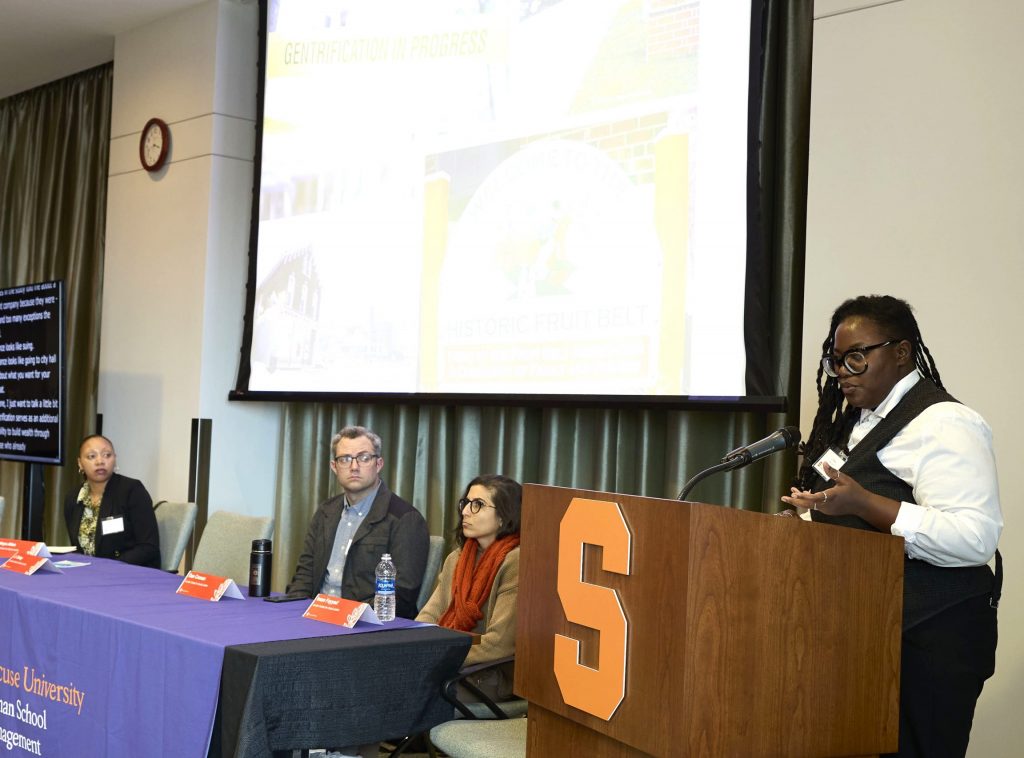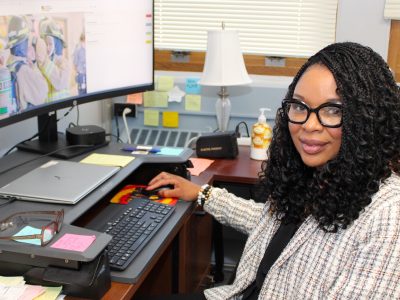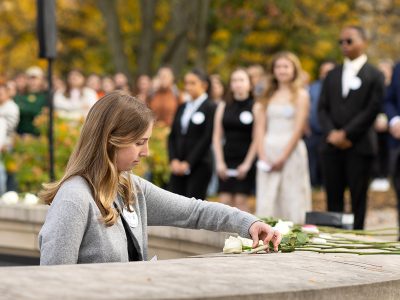Lender Center Postdoctoral Fellow Examines the Impact of Gentrification and Displacement in Western and Central New York
Growing up in Rochester and attending the University of Buffalo, Lender Center for Social Justice Postdoctoral Fellow J Coley saw firsthand how gentrification and displacement impacted those communities.
Now, Coley (they/them) studies how the policies and actions of local, state and federal governments and public officials, as well as those of private investors and property buyers, affect poor urban neighborhoods and residents in Buffalo, Rochester and Syracuse, looking at all three as representative of midsize Rust Belt cities. The researcher recently presented their early findings at the Lender Center Racial Wealth Gap Symposium.
“American slavery, segregation, Jim Crow laws, redlining and urban renewal have left Black Americans more likely to reside in neighborhoods that are under-developed and under-resourced,” Coley says. “Those conditions have direct impact on Black Americans’ ability to build wealth. Historically racist policies affect the life cycle of people and impact where they can live, their chances at opportunity and their quality of life.”

A sociologist, Coley spent the last two years conducting extensive interviews with current and former tenants and homeowners in the African American Fruit Belt neighborhood of Buffalo, where residents organized to gird against the impact of early gentrification. Coley wanted to determine how the process of gentrification in Black neighborhoods occurred, how residents resisted it and how they responded to being displaced, dislocated and/or isolated because of it. Coley also examined how residents described the levels of trust or mistrust they had for anchor institutions (such as banks, medical centers and big developers) that had begun to cause changes to their neighborhood. The interviews yielded four common reactions, Coley says: “nothing new,” frustration, resistance and “make it right.”
Many of the residents Coley interviewed were longtime community members who had lived through urban renewal. Their experiences put them “in a constant state of preparing themselves for what they feel is inevitable: displacement,” Coley says.
According to Coley, infrastructure also plays a part in the characteristics of a neighborhood and can restrict access to resources. For example, Buffalo’s main street “divides Black Buffalo and white Buffalo in that 80% of Black people live on the east side. It’s an area of concentrated poverty. People don’t think about how that impacts your ability to get to certain resources, but conditions like that impact everything.”
A Highway Parallel
In Rochester, as in Syracuse, a dilapidated highway is being torn down, Coley notes. While that will make way for more green space and area revitalization, it will still disrupt neighborhoods and potentially lead to the displacement of existing residents. Rochester’s Inner Loop North expressway and Syracuse’s Interstate 81 viaduct projects also illustrate why residents may resist change they don’t think benefits them or their neighborhoods, they say.
“Institutions need to be better collaborators with communities and include them in the changes that are happening in their neighborhoods,” Coley says. “People don’t have to have a Ph.D. for you to listen to them. They’re the experts at what they’re experiencing. I’ve talked to some 90-year-old women who have 50 years of experience in their neighborhood. They’re there every day; they know what they need.”
Further contributing to the racial wealth gap, the gentrification of poor urban neighborhoods threatens Black Americans’ ability to build wealth through home ownership, Coley says. That’s because as property values in those areas rise, residents may have more difficulty affording their homes.

“People don’t really understand how policies created decades ago are still having an effect on peoples’ ability to build wealth, have equity and see and be seen in our society. When institutions and developers come into neighborhoods, we need to do a better job of holding them accountable and making sure they are good community partners and neighbors. We need to make sure they are investing in and not taking away from the communities.”
Institutional Support Essential
The support of institutions like Syracuse University is essential to changing and improving government actions and programs that address the deterioration of neighborhoods, Coley believes. They say enacting progressive policies, such as establishing community land trusts and payment-in-lieu-of-taxes programs, can also help.
“It’s really important that the University and other institutions are acknowledging the situation and putting the topic at the forefront,” Coley says. “That’s especially so because so many regions and institutions in this country are not doing that.”
When their fellowship ends in 2025, Coley will continue to study these issues. They plan to stay in academia and seek a tenure-track position as an assistant professor at a research university. Based on their experience with other scholars creating the Buffalo Syllabus, a collection of images and writings that emerged after a targeted mass shooting in a Black neighborhood in Buffalo, along with their current research, they also plan to write a book based on gentrification and the displacement that occurs in some poor, urban Black neighborhoods.



